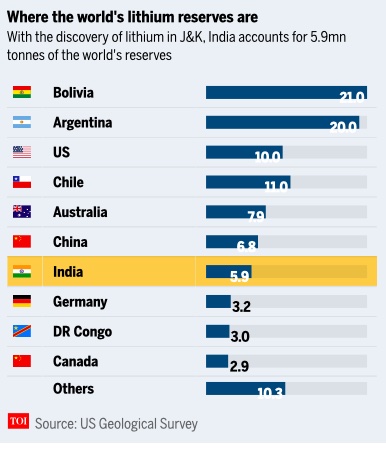Lithium: India
This is a collection of articles archived for the excellence of their content. |
Reserves
Salal-Haimana area of Reasi district of Jammu & Kashmir
Research- Rajesh Sharma, February 21, 2023: The Times of India

From: Research: Rajesh Sharma, February 21, 2023: The Times of India

From: Research: Rajesh Sharma, February 21, 2023: The Times of India
On February 9, the Geological Survey of India (GSI) announced that it had “for the first time established 5.9 million tonnes inferred resources (G3) of lithium in the Salal-Haimana area of Reasi district of Jammu & Kashmir." According to senior government officials, the lithium discovery is of the best quality. And with this discovery, India now has the seventh largest resource of lithium globally, though it will take time to convert this into reserves. So what is lithium? Lithium, a non-ferrous metal, is one of the key components in electric vehicle (EV) batteries. It is about half as dense as water and, in its pure, elemental form, is a soft, silvery-white metal. Being highly reactive, it is never found naturally as a metal. What does the government mean when it says “inferred resources” of lithium? Simply put, inferred resources indicate a preliminary stage of assessment where the “tonnage, grade and mineral content can be estimated with a low level of confidence”. That is, the presence of the mineral is “inferred” from geological evidence but not verified for viability. G1, G2, G3 etc are a measure of the confidence level as to the availability of a mineral. Lithium finds in India have mostly been of the G4 level, which indicates that prospects are of an exploratory stage.
Where does lithium typically come from?
There are two primary sources to obtain lithium:
Lithium brine deposits are accumulations of saline groundwater enriched with dissolved lithium. Although abundant in nature, only a few regions in the world, most in South America, contain brine.
Lithium found in ‘hard rock’ is a part of minerals hosted in pegmatites, rock units formed when mineral-rich magma intrudes from magma chambers into the Earth’s crust. As the magma cools, water and other minerals become concentrated.
Why is this discovery in J&K such a big deal?
The discovery is strategically important for India as it will go a long way in solving shortage of lithium, a key component of lithium-ion batteries used in EVs, harnessing solar power, wind energy and other chargeable instruments. All of which will help India’s efforts of moving towards a net zero emission goal by 2070.
Lithium is also added to glass and ceramics for strengthening, alloyed with aluminium and copper to save weight in airframe structures, and used in certain psychiatric medications.
Currently, India imports all the lithium it needs and in 2022, its imports amounted to almost Rs 14,000 crore. At current lithium prices, the current discovery is valued at a whopping Rs 34tn. What’s better? As against the normal grade of 220 parts per million (PPM), the lithium found in J&K is of 500 ppm-plus grading, say government officials.
How much lithium does the world have?
The United States Geological Survey (USGS) said in 2022 that total lithium resources globally stand at 80 million tonnes although the reserves from which it can be accessed were pegged at just over 22mn tonnes.
Though found on each of the six inhabited continents, Chile, Argentina, and Bolivia—together referred to as the “Lithium Triangle”—hold more than 75% of the world’s supply beneath their salt flats.
Why is lithium demand so high?
Booming global EV sales have led to lithium consumption to double over the past two years. Consumption is expected to reach 1.5mn tonnes by 2025 and over 3mn tonnes by 2030.
With suppliers unable to keep pace, a blistering price rally sent the total spot value of lithium consumption rocketing to about $35bn in 2022, up from $3bn in 2020, according to Bloomberg.
Can the discovery mitigate China’s lithium dominance?
China does not have too much lithium reserve of its own, but as the largest market for EVs, it has over half the global lithium processing and almost 75% of cell components and battery cell production in the world. Therefore, the proliferation of EVs could mean India becoming dependent on China.
J&K’s reserves, however, provide a major opening for India to be self-reliant. It will make EVs more affordable domestically, and India will also be able to tap into surging global demand.
What’s the environmental impact of lithium mining? Lithium is most often found in underground reservoirs, and mining it is known to contaminate and cut off scarce water sources in rural communities. Mining can also leave contaminants and toxic waste behind. There are other issues as well. One, extracting lithium from its ore is highly water-intensive — it takes about 2.2mn litres of water for one tonne of lithium. Two, the production process involves heating the ore at a high temperature that can only be cost-effectively reached by burning fossil fuels, meaning that for every tonne of lithium, 15 tonnes of carbon dioxide are emitted into the air. Finally, with the Himalayas being highly fragile and eco-sensitive, mining lithium may lead to long-term adverse consequences. Mining in the region is sure to attract opposition from environmentalists.
Is this really a new discovery?
In 1999 almost 24 years ago, the GSI had submitted a detailed report about the presence of lithium in the same area. But there seems to have been no meaningful follow-up until now.
A 67-page report in 1999, prepared by GSI scientists KK Sharma and SC Uppal had said “the prospect of lithium appears to be promising” in the Reasi belt, flagging high values of lithium “persistent throughout the belt”. The report had also credited MR Kalsotra, the then director for mineral investigation operations, for carrying out trace studies and reporting “high values of lithium” in 1992.